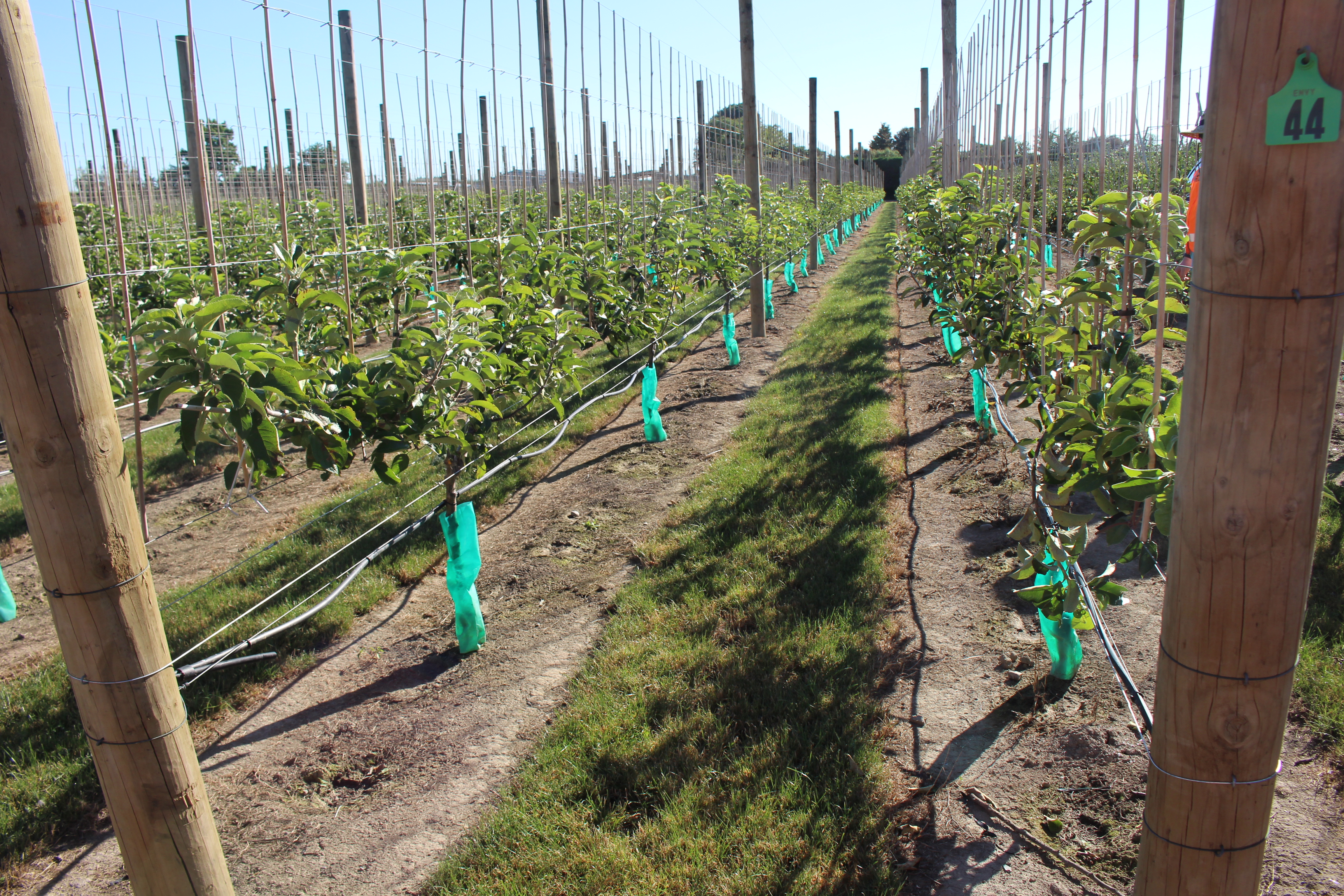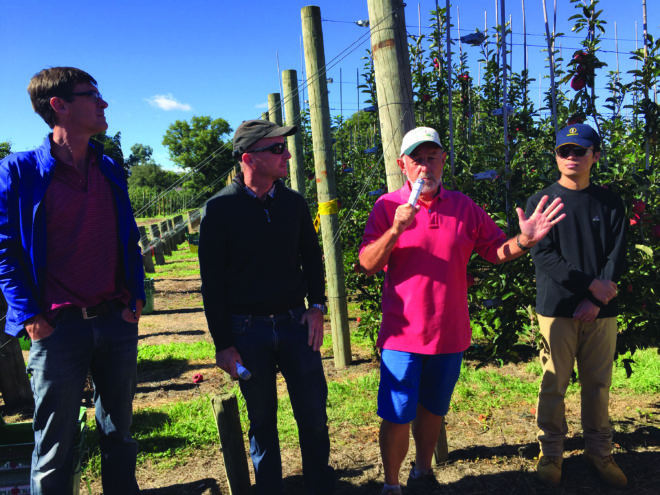
May 15, 2019‘Future Orchard Production System’ drives orchard outlook
With heightened attention being given to labor-saving robotic harvesters and other innovative tools for tree fruit growers, a continued concentration is being given to the development of orchard planting systems that will be able to accommodate such breakthroughs.
In recent years, researchers have indicated the optimum planting density will likely remain close to 1,000 apple trees per acre. As growers become more adept at managing this density, they will likely plant slightly closer, with densities close to 1,300 trees per acre. If they adopt summer shearing to reduce cost and maintain a narrow canopy wall, they will slowly move from 12 feet between the rows to 11, 10 or even 9 feet between rows.


Apple Orchard architecture trends were on full display during an International Fruit Tree Association (IFTA) Tour of New Zealand in early 2018. The Future Orchard Production System (FOPS) was in place at one of T&G Global’s commercial orchards.
EnzaFruit Products is the U.S. subsidiary for T&G Global, and the FOPS could take hold in the U.S.
The T&G Global goal was to determine the next step in maximizing production, implementing automation on a wide scale. The group recently claimed success in a commercial apple harvest by a robotic system.
In a climate that features plenty of sunlight and frequent wet conditions, T&G Global’s New Zealand operation is looking at a FOPS system and also a V-trellis to provide a way to divert the vigor into fruit production while also increasing per-acre production.
“We need to get higher efficiencies of land,” said Morgan Rogers, head of quality and innovation and ROW Manager for T&G Global. “We’ve got to put fruit on trees to help manage vigor.”
Rogers displayed a 4.3-acre planting that is intended to last more than 25 years.
The FOPS approach works best in a 7.5-foot tree spacing, Rogers said, to achieve “just a bit more shoulder room.”
Clear path to automation


Mechanical harvest is clearly in mind with the development of FOPS, which lends itself to mechanical equipment due to its vertical wood structure.
“We have to systemize, take out variability, and be ready to automatize,” Rogers said. “We want to dial in a tree profile and mitigate any variability.” He believes consistency in orchard design will attract a more stable and better-trained labor force.
Stuart Tustin has been science group leader for the Crop and Fruit Production Systems Group, of the New Zealand Institute for Plant & Food Research, located at the Hawke’s Bay Research Centre, Havelock North, in one of New Zealand’s major fruit growing regions for apples, stone fruit and winegrapes.


Tustin followed up on talks given about the FOPS concept in North America with a tour for IFTA tour participants of the orchard prototype at the New Zealand Plant and Food Research Center.
Trees are grown in a planar cordon system, with multiple vertical stems to control and distribute the canopy growth.
“The tendency is to see the tree design as innovative,” Tustin said. “We use the natural growth of the tree to enhance fruit production.”
A FOPS 2-D planar cordon system was in its fifth leaf. Trees in the systems are about 7 feet or 5 feet apart, in either a vertical cordon or a V-cordon. In the vertical cordon, 10 uprights are spaced about 11 inches apart. In the V-cordon, 12 uprights are spaced about 10 inches apart.
Tustin says the research team is looking to harvest about 80 or 90 bins per acre this year, with the goal of reaching 100 or 110 bins an acre next year.
The target with this system is to reach yields of 150 to 200 bins per acre, Tustin said. With an ultimate goal to reach 80 percent light interception, Tustin said the 7-foot tree spacing showed approximately 60 percent light interception and the 5-foot tree spacing allows for 70 percent light interception.
Canopy structure crucial
Tustin initially introduced FOPS to IFTA during its 2017 annual conference in British Columbia, Canada. His self-described “provocative” Carlson Lecture took attendees to “the edge of the fruit universe.”


He encouraged growers to consider a planar cordon concept that features multiple stems to control and distribute the canopy growth. The ultimate goal is to increase light into the canopy.
Bi-axis trees offer many benefits, Tustin said. Not only filling in space with less trees and closer rows, but bi-axis trees grow 30 percent more dry weight than a single leader tree.
“If we manage light and the canopy, we don’t see the need to renew uprights at all,” he said, noting pruning increases vegetative growth. “We prune too much. A little is good, too much is bad.
These planar cordons help distribute growth on the tree evenly. The planar canopy inhibits branching from apical dominance. This minimal branching and growth allows the tree to devote its resources directly to producing fruit.
“Fruit is the only growth regulator I trust,” Tustin said. “It’s the cheapest one you have.”
Canopy management is best achieved by using the minimum branches needed to achieve the maximum light interception – getting more fruit from less tree, Tustin said. Quantity is important, but quality must be a focus of tree management.
“We’re getting substantial fruit for light interception,” he said.
Properly managed orchards in current system, he said, can max out at 100 bins an acre, but this production will level out as a function of orchard design.
Tustin acknowledged that while the planar canopy system looks promising, growers may be hesitant to implement the philosophy.
“We’ve got a heck of a lot invested in current orchards and that’s not going to go away overnight because some guy says we should have upright fruiting shoots,” he said.
Tustin voiced concerns about robotics being forced upon the industry without enough emphasis being put on orchard structures that can accommodate such equipment.
“Let’s bring robotics to amend horticulture,” he said.
– Gary Pullano, managing editor














